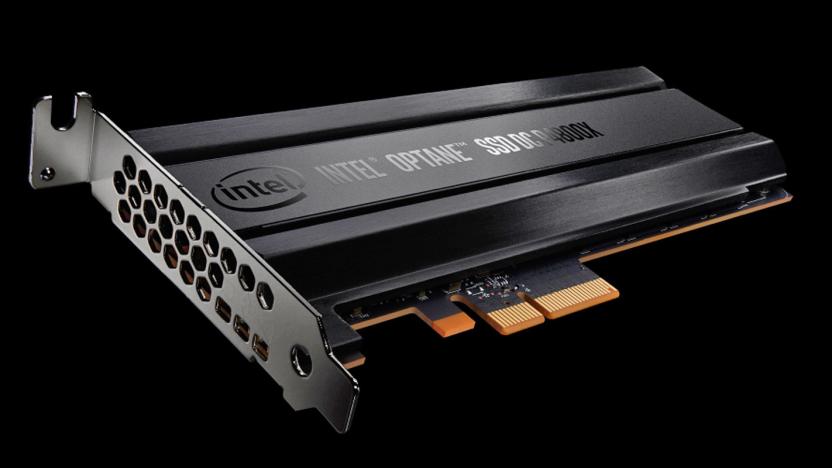3dmemory
Latest

Intel's first hyper-fast 3D drive is meant for servers
At last, Intel is making a stand-alone drive based on its extremely fast 3D storage technology... although you're probably not about to pick one up yourself. The chip maker has unveiled the Optane SSD DC P4800X, a drive destined for the PCI Express or NVMe slots in servers. It only has 375GB of space, but its extremely low latency (typically under 10µs) and 2GB/s throughput means that it can serve as either a memory cache or storage. If you're involved in high-performance computing, online shopping or other categories obsessed with gobs of RAM and rapid turnaround times, this is theoretically your dream device.

The big memory cube gamble: IBM and Micron stack their chips
Manufacturers have been murmuring about 3D memory chips for years, but an escalation in recent radio chatter suggests the technology is on the cusp of becoming commercial. Intel unveiled a Hybrid Memory Cube (HMC) at IDF, which promises seven times the energy efficiency of today's DDR3, and now IBM and Micron have shown their hand too. The pair just struck up a partnership to produce cubes using layers of DRAM connected by vertical conduits known as through-silicon vias (TSVs). These pillars allow a 90 percent reduction in a memory chip's physical footprint, a 70 percent cut in its appetite for energy, and -- best of all -- a radical increase in bandwidth: HMC prototypes have already scored 128Gb/s 128GB/s, which makes 6Gb/s SATA III look like a bottleneck. It certainly sounds like a game-changer, unless of course some rival technology like ferroelectric memory gets there first. Update: Doh, sorry for the wrong caps, which were shrunken by a factor of eight. For comparison, current high-level DRAM delivers around 12.8GB/s. [Thanks, Maximilian]

SanDisk and Toshiba join efforts to build "3D" flash
We first heard about Toshiba's plan to increase NAND flash capacities by building "3D" memory chips with "pillars" of stacked cells in January of 2007, but it looks like the effort is getting revived -- Tosh and SanDisk have entered into an agreement to jointly develop and cross-license 3D memory tech. SanDisk was once rumored to be developing write-once 3D flash chips, so both companies have experience building the stuff, but it sounds like it'll take another three or four years for the partnership to produce actual products, as high-yield production is still difficult.

1GB write-once SanDisk memory cards to cost $5.99?
Remember how Sandisk was flirting with read-only, cheap-archival storage based on their new "3D memory' back in February? Well, it sounds like they're about to commit. We just received a tip from a SanDisk customer who took a survey about a proposed write-once memory card. The most interesting new piece of information is the price: a 400 photo, 1GB write-once card for a proposed $5.99 as described by our tipster. We can't vouch for his claims -- nevertheless, what he says is consistent with what we've heard and certainly makes sense. We'll break it down for you as we received it: The new "memory cards (memory stick)" will be widely available in food, drug, camera, and convenience stores (we already knew that Wal-Mart and Walgreens were involved) The new format fits your existing camera Large enough to store at least 100 photos per card (does that mean 256MB cards for $2.00 or less?) Write-once technology stores your pictures safely for over 100 years (check) Less expensive than standard re-writeable memory cards (duh) No dates were provided in the survey, but at this point, a near-term launch certainly appears imminent.[Thanks, Chris G]

SanDisk secretly concocting read-only memory for archival use?
Getting wind of a flash memory successor is far from new, but a major player in the flash game now seems to have something a bit counterintuitive going on behind the scenes. After slashing jobs and prices in an attempt to "keep up with competitors," SanDisk is now reportedly delving into the "read-only memory" realm, as it seeks to create a product that acts as a "cheap archival device." Although the company is remaining tight lipped about the details, this self-proclaimed "3D memory" is said to last "up to 100 years" and become the "new digital film," but we're not exactly sure the digital disposable market is apt to boom anytime soon. Moreover, SanDisk seems to hope that this new creation will "remove the PC from the equation," allowing users to relive to excruciating annoyance that is developing film in-store while removing the ability to delete photos or overwrite bad snapshots once taken. Nevertheless, the memory is purportedly being tested in a retail pilot program, and Greg Rhine (head of SanDisk's consumer business) noted that Walgreens and Wal-Mart both raved over the invention, as it would theoretically force more customers to revert to ages ago when OTC development was an unfortunate mainstay.


